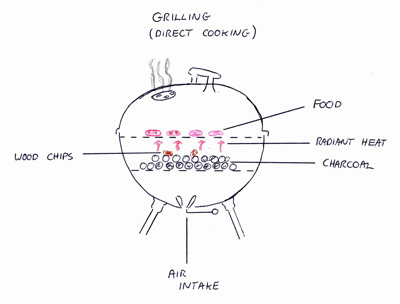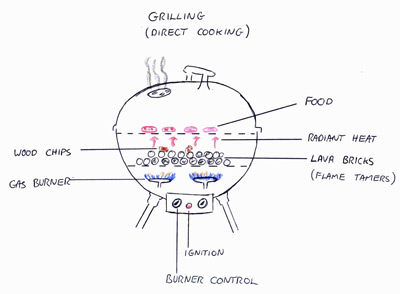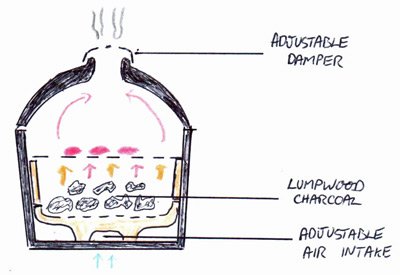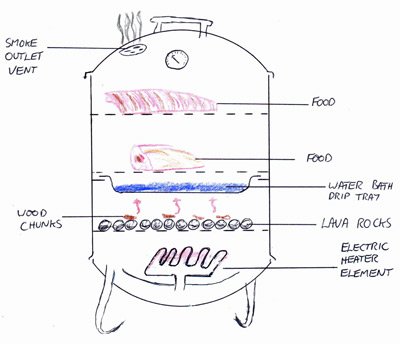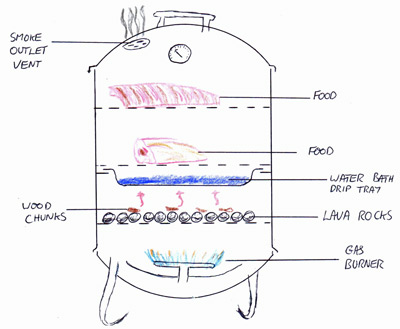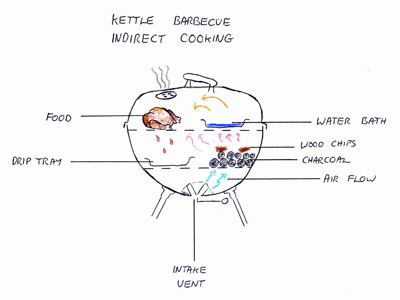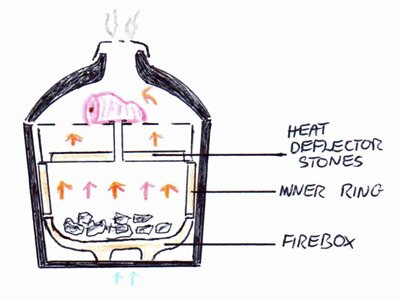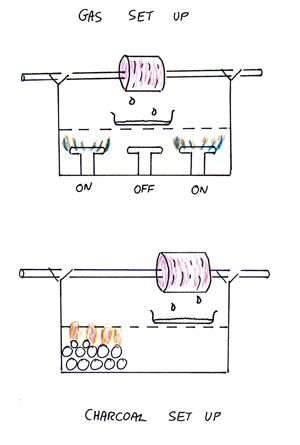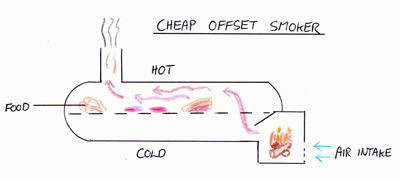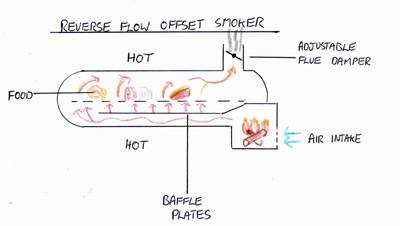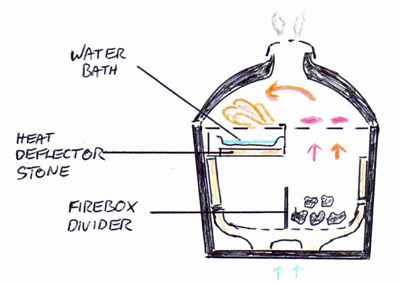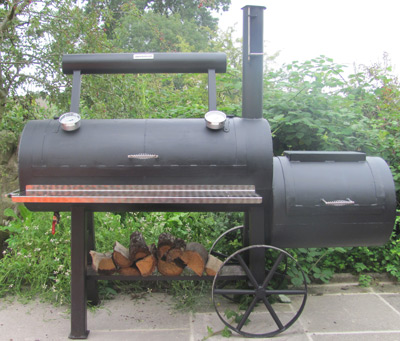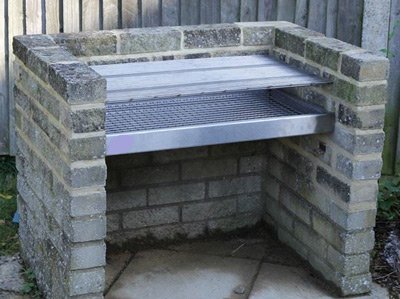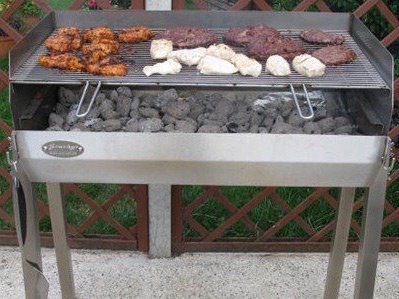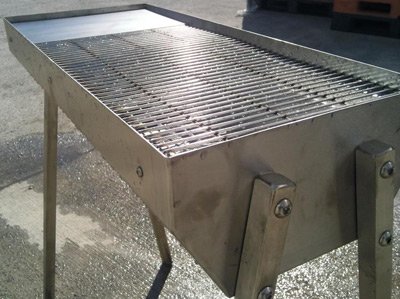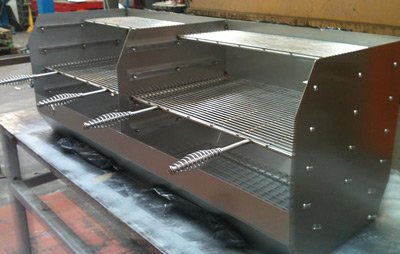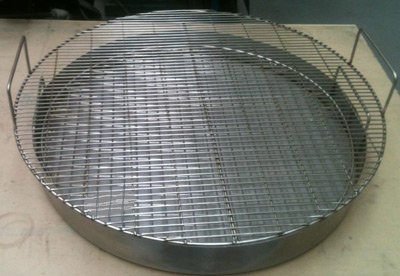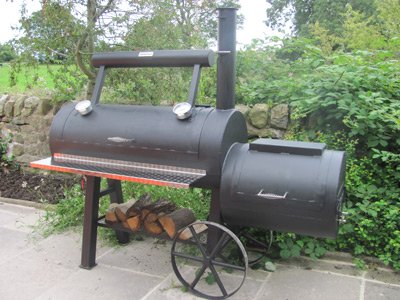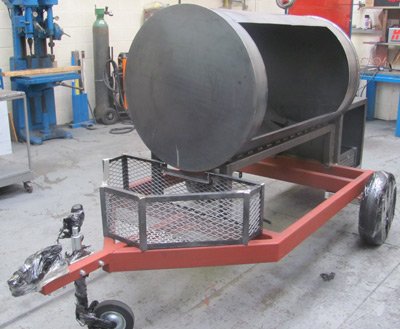- Recipes Home
- Beginners Guide & Glossary Of Terms
Beginners Guide To Barbecue
The beginners guide to barbecue smoking and grilling is here because I want to ensure that everyone feels comfortable cooking outdoors and no-one feels worried that they don't know enough to give it a go.
I take part and contribute to a number of barbecue fora around the world, generally they are a good source of information and they are great way to hook up and share with other like minded people BUT... Despite the many posts and conversations each forum suffers from:
- 80% of the conversations being between the 20% core of "know it alls" (and yes I'm one of these guys too).
- Lots of acronyms and abbreviations that many newbies don't get.
- A selection of retailers who have a commercial interest in selling you a BBQ and will prey on anyone who asks for an equipment recommendation.
To be fair, I'm biased too. There are grills that I love and smokers that I dislike (and vice versa) but this beginners guide to barbecue isn't going to make any equipment recommendation other than to say "buy a barbecue with a lid" because the lid makes any barbecue so much more versatile. This will become evident when you read the section on direct and indirect cooking. For more detailed equipment info see my guides to:
Before all the owners and moderators of BBQ fora around the world dump on me from a great height let me re-iterate that a good BBQ forum is still a friendly place to network with the some great barbecue enthusiasts. My personal favourite is the UK Facebook group Country Wood Smoke.
It's also fair to say that barbecue themed websites (even mine!) to some extent also suffer from the same problem. At the end of the day I'm an enthusiast with many years experience of outdoor cooking (just like the other idiots that decide to write a website about barbecue).
As someone who has been barbecue cooking for 35 years it's sometimes easy to assume that you (the reader) knows the basics and on the flip side it's also easy for me (the writer) to completely ignore a basic piece of information because "it's obvious".
So the purpose of my beginners guide to barbecue is first to apologise in advance for my lack of understanding and secondly to try and deal with the basics of outdoor barbecue cooking.
In addition to this page resource, remember that you also have two other options to help clarify a point:
- Use the search box at the top of the page. Just type in your query, press enter and (hopefully) a page will be suggested that answers your question. Use this method before going to option 2 to check whether a question has been asked before.
- Ask me! Use this form to ask me a question, I'll then do my best to answer it and open it up to the all who read my site regularly and between us we usually come up with a pretty comprehensive solution.
One last point to make is that I'm English and despite the fact that this site is written in English there are certain words that don't translate around the globe so at every point I'll try and cross reference to alternative descriptions. If you are unsure of anything then you can always refer to my glossary of terms.
Direct And Indirect Cooking
There are many methods and styles of cooking throughout the world and BBQ is no different. You can however break barbecue down into two distinct cooking methods.
Direct Cooking
Direct cooking is where the heat source is (generally) under the food to be cooked. The heat source effectively emanates from one direction so food cooked directly is cooked on one side at a time and will need turning to ensure that it is cooked on all sides.
Direct cooking is generally referred to as grilling and reserved for smaller food items. Examples include searing steaks, grilling chops, burgers, fish or veggie slices and cooking time is usually short (between 5 - 30 minutes). Longer cooking than this will usually result in a dry offering.
The following images will help you understand the direct cooking method on various pieces of equipment.
Charcoal
Note how direct cooking is still done with the lid down as this helps impart a smoky flavour and retains the heat.
Gas
Whilst the principle of direct cooking is the same on gas, there are actually two forms of heat involved - radiant heat as shown in the diagram and also convection heat from the burners as heated air circulates around the lava bricks / flame tamers.
Kamado
With the lid closed, a ceramic kamado can cook directly with minimal air flow and this means less drying out and more succulent results.
Indirect Cooking
Indirect cooking on a barbecue uses convection heat (air flow) like in a conventional oven. The primary feature of indirect cooking is that there is separation between the food and the heat source. This can be achieved by positioning of food in relation to the heat source or by a physical barrier, depending on the barbecue you have, indirect cooking can be set up in a number of ways.
Electric
In the graphic above you can see that the lava rocks and the water bath provide a physical barrier between the heat source and the food.
Gas
The gas option on this bullet smoker is pretty similar to the electric version above. For indirect set up on a gas grill (with a lid) check out the rotisserie examples below and you'll get the idea of how to arrange the burners.
Charcoal
Note how the separation between the charcoal heat source and the food in this graphic above is simply by positioning the food at the opposite side of the grill to the charcoal.
Kamado
With a ceramic kamado there is a physical barrier of the heat deflector stones which block the radiant heat. If you decide to spend on a ceramic kamado it's vital that you get the heat deflector stones otherwise the full versatility of the kamado is lost and you are wasting your money.
Rotisserie Set Up
Note: With the rotisserie set up above you would still have the lid down on your grill.
Offset Smoker
Finally here is indirect cooking on an offset and reverse flow smoker.
Indirect cooking is used for larger cuts of meat and other foods that require longer cooking times and because it's convection heat that can circulate all around the food there's no need to turn food while it is cooking.
Temperature control is also more significant with indirect cooking. For example you can bake or roast at traditional oven temperatures (eg.180°C or 350°F) and you can also cook at lower temperatures (110°C or 225°F) for longer periods of time - referred to as "low and slow" cooking.
As you've seen in the diagrams above, indirect cooking can be done using a variety of heat sources, electric, gas, charcoal or wood and with the latter two, fuel is added a regular intervals to maintain temperature. This is known as "tending" the fire.
The addition of smoke whilst cooking at the low and slow temperature is defined as "hot smoking" or (in North America) "barbecue".
Two Zone Cooking
Having said that there are 2 distinct barbecue cooking methods, there is actually a third and it's a combination of the two above where you effectively create 2 cooking zones on your barbecue.
- one area with hot direct heat
- the other area with cooler indirect heat
This set up can be used in one of three ways:
- To cook food in different ways at the same time.
- To cook indirectly to warm food up and then finish off and crisp the outside over direct heat (known as the reverse sear technique and used for steaks).
- To cook directly seal and brown the outside and then transfer to the indirect area to cook through.
This set is demonstrated below with the split heat deflector stones in a ceramic kamado.
This set up is only possible in a kamado when you have the split heat deflector stones. It's more simple in a kettle where the 2 zones are created by the positioning of the food on the cooking grate and having the hot coals sited at one side.
So there are three methods of cooking on a barbecue. In addition there are three cooking processes used in outdoor cooking and at the risk of complicating the issue I'll try and define each process because this may help explain a little more about the difference between the heat source option that you choose for your barbecue.
Radiation
This is when the you can feel the warmth directly from the heat source. The best example of this maybe when you feel the heat from the sun and in barbecue terms this is the heat given off when direct cooking with charcoal.
Convection
Heat is circulated through the air like in a fan oven. It's convection heat used in indirect cooking and in direct cooking on a gas grill where you get both radiant and convection heat.
Conduction
Heat transferred by immediate contact. The best example of this is a hot-plate or plancha.
Glossary Of Definitions, Abbreviations And Acronyms
The next section of the barbecue beginners guide is my glossary of barbecue terms, abbreviations and acronyms, some that I've used on my website and others that I see being used in barbecue circles the world over. I've also included words that you might see written by an American and translated those into "proper" English (wink wink) or indeed words that I've used that need translation into American.
A B C D E F G H I J K L M N O P Q R S T U V W X Y Z
A
Afterheat - The distribution of heat through a piece of meat when it is being rested (after it has been removed from the heat). The afterheat can increase core temperature by as much as 5°C or 9°F. Also known as carryover heat.
Al dente - the texture of veggies when cooked "to the tooth" (Italian). They are not soft but tender with a snap to the texture. Applied to asparagus, broccoli etc.
Asado - Spanish for "roast". A traditional method of grilling meat in Latin America
B
Barbecoa - Central American, thought to be the word from which the French derived the word "barbecue"
Barbecue - how North Americans describe low and slow cooking over smoke and what the English describe as hot smoking. A barbecue to an Englishman is a charcoal or gas grill to an American.
Bark - The dark crust that forms on meat when cooked low and slow. A combination of the meat drying out, any rub applied prior to cooking and the Maillard reaction.
Baste - The process by which meat juice, rendered fat (or a flavoured liquid) is spooned over meat during cooking. See also mop.
BBQ Guru - Brand name for a neat piece of kit that monitors oven temperature and then adjusts airflow (by use of a fan) to maintain cooking temperature within set parameters.
Bear Paws - Brand name for hand tools designed to shred meat.
BGE - Abbreviation for Big Green Egg, the original kamado brought to the mass market.
Braai - The South African word for barbecue. Typically a social occasion where wood is first burned to create the charcoal and then the cooking takes place. In the UK a Braai now refers to the piece of equipment similar to a parilla used rather than the event.
Brine - A salt based solution that (dependent on concentration) can be used either to moisturise meat and aid water retention during cooking or to dry meat for preservation as part of a curing process.
Briquette - A spherical block of compressed charcoal and cellulose. Briquettes burn at a high temperature for a constant period of time but deposit significant dust residue.
Brisket - Cut of beef just above the shank. Whilst the approximate position of this cut is the same in the animal whether you live in UK or America, the precise cut is actually slightly different.
BTU - British Thermal Units, 1 BTU is the amount of energy required to raise the temperature of one pound of water 1°F. Metric equivalent is a Joule which is the amount of energy required to raise the temperature of 1 kg of water through 1°C. US manufacturers use BTU to describe the power of a burner however it must be noted that BTU is a measure of power consumption and not output.
Bullet Smoker - A smoker usually made out of thin pressed aluminium as shown in the above graphic. The most recognised (and respected) brand of bullet smoker is the Weber Smoky Mountain.
Burnt Ends - Crispy cubes made from the fattier end of the brisket
Butt - The American term for the shoulder of pork
Butterflying - The procedure to remove the bone from a leg or shoulder cut so that it can be laid flat on the grill and cooked directly.
C
Carryover - The distribution of heat through a piece of meat when it is being rested (after it has been removed from the heat). The carryover can increase core temperature by as much as 5°C or 9°F. Also known as after heat.
Casing - The sheath into which sausage meat is stuffed to create sausage. Casings can be made from a number of materials, some edible, some not.
Ceramic - Common description for a kamado ceramic BBQ grill
Charcoal - The fuel for many barbecue grills made from the combustion of wood in a low oxygen environment. Charcoal is usually sold as lumpwood or briquettes.
Chine - The process of removing the connective tissue from the rib bone of a chop. Unnecessary waste in my book but essential if fine dining.
Churrasco - Brazilian rotisserie cooking on an almighty large skewer fashionably served vertically and suspended so you can slice hunks of meat off the skewer as you dine.
Cilantro - A green herb used in Indian cookery. UK English is coriander
Cloche - A bell or dome shaped cover used with plancha cooking to add moisture to the food under the cloche.
Cold smoking - A process of using smoke for flavour and preservation but not for cooking. The process takes place at temperatures lower than 29°C or 85°C. Examples of cold smoked product include smoked salmon and cured smoked sausage.
Collagen - Fibrous connective tissue that is chewy in texture. Collagen melts and moisturizes meat during low and slow cooking which is why meat cuts that are high in connective tissue are chosen for smoking. Collagen is also processed and dried for the manufacture of sausage casings.
Conduction - The process of cooking by direct heat transfer such as hot-plate or plancha cooking.
Confit - The process by which meat and vegetables are slow cooked in fat or oil.
Convection - The process of cooking where heat is conveyed by airflow.
Coriander - A green herb used in Indian cookery. American English is "cilantro"
Cover - A butchers term for hard fat that doesn't render significantly when cooked (and doesn't allow the penetration of smoke). In America it is referred to as the fat cap. For bacon curing you want good cover but on a pork shoulder you want the cover off.
Cracklings - The rind of pork cooked in fat until crispy. Served in the UK as a bar snack called a scatching.
Cup - A volumetric measure used in North America. Different ingredients have different densities so to relate the cup uniformly to a weight is not a good calculation. To be exact I always use this conversion calculator.
Curing - The process of preserving meat by drying in salt. Use this link to learn more about curing meats.
D
Dirty cooking - Cooking meat and veggies directly on the charcoal or wood embers. Dust off any embers that stick to the food and enjoy.
Dutch oven - An earthenware or cast iron pot used for cooking casseroles.
E
Emulsion - A blend of two liquids that won't dissolve. The best example is water and oil in a salad dressing but I've also used the term a lot when making homemade sausage.
Emulsifier - A substance that aids emulsification
F
Fat cap - Referred to as "cover" by UK butchers. It's the hard fat that doesn't render significantly when cooked (and doesn't allow the penetration of smoke). For bacon curing you want the fat cap on but on a pork butt you need to remove the cap if smoking.
Firebox - The chamber in a smoker where the fire is sited. In an offset smoker the firebox is set to the side whereas in a ceramic kamado it is integral to the shell.
Frank - Slang abbreviation for a Frankfurter sausage.
G
Grate - The rack where the food is positioned to be cooked. UK equivalent is the grill.
Griddle - A cast iron hotplate or pan that uses conduction heat to cook.
Grill - The UK equivalent of a cooking grate. The US term for a barbecue and the verb to apply direct radiant heat. (All very confusing).
H
Heat Beads - Brand name for a type of charcoal briquette designed to burn hotter and longer than standard briquettes. Marketed toward use with kettle barbecues.
Hibachi - A lined heat proof box that holds charcoal. Of Japanese origin primarily designed to heat the house they can also be used to cook on. Similar to Yakitori.
Hot links - Spiced pork sausages found on barbecue menus in the Southern states of America.
Hot plate - Usually made of cast iron and sited over a heat source for direct conduction cooking and searing. Also Spanish plancha and a griddle.
Hot smoking - Cooking indirectly at 110°C or 225°F whilst passing smoke food. Commonly referred to in North America as barbecue.
I
Indirect cooking - Outdoor cooking using heat transfer by convection. See our detailed explanation of the difference between direct and indirect cooking.
J
Can anyone think of a BBQ term beginning with J?
K
Kabob - Cubes of meat and veggies cooked on a skewer. American spelling of kebab.
Kamado - Ceramic barbecue grill, for more detail click here.
KCBS - Kansas City Barbeque Society. The largest BBQ club in the world and benchmark rule setter for countless BBQ competitions around the globe.
Kebab - Cubes of meat and veggies cooked on a skewer. UK English spelling of kabob.
KJ - Abbreviation for Kamado Joe, a brand of kamado.
KW - Kilo Watt. Unit of measure for power output. Used in Europe to quantify the power of gas burners.
L
Links - Individual sausages. Technically the link is the twist in the casing that separates the lengths of sausage meat but people tend to refer to the sausage as the link. Also hot links.
Liquid smoke - The condensed product of the destructive distillation of wood used extensively in mass produced barbecue sauces to give them a smoky flavour. Used in ancient times as embalming fluid, now why would you want to put that in your food?
Low & Slow - The process of cooking at "low" temperature (110°C or 225°F) for a long period of time.
LPG - Abbreviation for liquid petroleum gas. It can be either propane or butane but for the purposes of barbecue it's tank gas or bottled gas.
Lumpwood - Pure unprocessed charcoal derived from the burning of wood in a low oxygen environment. Charcoal in this state looks like burnt tree branches.
M
Maillard Reaction - a chemical reaction that takes place in meat at or above 150°C or 300°F. Click here to learn more.
Marinade - A liquid used to flavour and tenderise meat. There are three types of marinade.
Maverick - Brand name for a type of barbecue thermometer.
Mop - Flavoured liquid that is brushed over food as it cooks. See also baste.
N
Natural Gas - Piped gas that comes into the home as opposed to tank gas or bottled gas.
O
Offset smoker - A design of smoker that is very popular in America consisting of a large (usually cylindrical) food chamber the a firebox heat source set to the side.
P
Parilla - An Argentinian style of grill. A wood fire is built to the side of the cooking grate, the embers drop down and are then scattered under the cooking grate.
Pellet grill - Electric powered grill / smoker that used sawdust bound pellets for fuel. Worshiped for their "set and forget" capabilities.
Picnic - American English for the lower section of the pork shoulder. UK English equivalent is the "hand"
Pimenton - Smoked paprika. A wonderful ingredient that adds a natural smoky flavour to rubs and sauces.
Pit - American term for any device that hot smokes / cooks barbecue. Originally it was a hole in the ground lined with wood hence the derivation of the word.
Pizza oven - Wood fired outdoor oven designed to cook at high temperature.
Plate setter - The Big Green Egg branded name for the heat deflector stone in a kamado.
Plateau - Also called the "stall". An interval in the cooking of pulled pork where the core temperature of the pork remains constant before continuing to rise. The duration of this temperature plateau can be hours but also can be shortened by wrapping the meat in foil and adding a little moisture.
Plank - A piece of wood designed for cooking on indirectly. Usually made of cedar and especially good for cooking fish.
Poaching - Method of cooking in hot (but not boiling water). Popular method of cooking hotdog sausages. Also means the illegal hunting of game without the permission of the landowner.
Pork Shoulder - The UK English equivalent of the butt
ProQ - Brand of smoker
Pulled Pork - Pork shoulder (butt) cooked low and slow until it falls off the bone. It's then shredded prior to serving. For recipes see my pulled pork section.
Q
Que - Abbreviation for the word barbecue.
R
Rack - The term for the meat and bones of multiple ribs. In barbecue circles the rack refers to the whole section and you may find it on a menu as a whole rack or half rack. In other dining circles you may see rack of lamb on the menu which typically will be three or four chops. I have also heard the term used to describe the cooking grate and also a barbecue basket.
Radiation - A method of heat transfer used in cooking. See my earlier notes.
Render - The process of melting fat
Reverse flow smoker - A design derivation of the offset smoker that helps deliver an even temperature across the cooking chamber. The design adds expense to an offset smoker but is well worth it. Click here to see the difference.
Reverse sear - A technique for cooking steak where the core temperature is slowly increased using indirect heat and then to finish off the steak is slapped over intense direct heat to brown, crisp and caramelize. Some chefs use sous vide techniques instead of the indirect stage.
Rotisserie - Or spit roast. A method of cooking food on a large rotating metal rod. The heat source can be either direct or indirect. Domestically most rods rotate around a horizontal axis above the heat source however is Southern Europe a vertical axis rotation around a side heat source is common. In Greece referred to as gyros.
S
Scratchings - UK English term for crackings, rind of pork cooked in fat until crispy and served as a bar snack.
Seasoning - Seasoning a smoker refers to the preparation process of firing a new smoker to burn off any oil or debris deposited during manufacturing that might taint the flavour of the first cookout. Also herbs and spices added to flavour meat.
Skewers - A length of metal or wood onto which meat and veggies may be threaded prior to create a kebab (kabob). Skewers come in all shapes and sizes so read my article to work out what's the best design for you.
Slider - Originally a small hamburger so called because it cold be eaten in one mouthful and "slide" down the throat. Now it's just a fashionable term for pretty much anything in a bun.
Smash Burger - An alternative way to form a patty where downward pressure is placed on a ball of meat. This produces a "jagged edge" to the patty giving a greater surface area to be exposed to the heat, which means more caramelization and therefore (in theory) more flavour.
Smoke Ring - The pink outer ring that's visible on a sliced piece of hot smoked meat. The visibility and depth of the ring are considered a sign of good barbecue. The smoke ring is only produced by certain types of smoker so read my article about meat smokers to understand why.
Smoking - The process of passing smoke over food (usually meat or fish) to add flavour and aid preservation.
Sous vide - French meaning "under vacuum". A fashionable way to cook by placing your food in a plastic bag, vacuum sealing it and cooking in a water bath at a controlled temperature. All the moisture and flavour is kept in the bag but there will be no Maillard reaction because water bath cooking is always at temperatures lower that 100°C or 212°F. Searing on a charcoal grill is a great way to finish of any sous vide cookery.
Spatchcock - Removing the back bone of a bird (usually a chicken) to flatten it so that it can be grilled over direct heat.
Spit Roast - Or rotisserie. A method of cooking food on a large rotating metal rod. The heat source can be either direct or indirect. Domestically most rods rotate around a horizontal axis above the heat source however is Southern Europe a vertical axis rotation around a side heat source is common. In Greece referred to as gyros.
Stall - Or Plateau. An interval in the cooking of pulled pork where the core temperature of the pork remains constant before continuing to rise. The duration of this temperature plateau can be hours but also can be shortened by wrapping the meat in foil and adding a little moisture.
Steaming - Method of cooking. Popular method of cooking sausages.
T
Tandoor - Clay oven used in Indian cooking similar in design to a kamado.
Thermapen - Brand name for a temperature probe. There are cheap imitation but I swear by these.
Tri-tip - Cut of beef from the lower sirloin renowned for low fat and good flavour.
Two Zone Cooking - The set up in your barbecue where you have both direct and indirect heat simultaneously available.
U
UDS - Abbreviation for a brand of smoker - Ugly Drum Smoker.
V
Vegan - Someone who prefers a diet exclusive of all animal products. Contrary to popular belief, every nutrient required to live (bar one) can be derived from a vegan diet. The only supplement needed is vitamin B12, something that we used to get from the soil but now our fruit and veggies are supplied to us washed, there's no natural natural source of vitamin B12 associated with them.
Vegetarian - Someone who prefers not to eat meat but will eat the products of animals eg. eggs, butter, milk, cheese.
W
Warm smoking - Smoking conducted at temperatures of 90°C or 200°F, used for making smoked mackerel.
Water smoker - A smoker that has a water bath between the heat source and the food. This water acts as a thermal store helping stabilise temperature and also provides humidity which is important for the production of the pink smoke ring. Most bullet smokers are water smokers.
Wienie - Abbreviation derived from the Vienna sausage similar to the Frankfurter.
WSM - Abbreviation for the Weber Smoky Mountain brand. A popular water smoker.
X
Xanthan gum - a natural product used as a thickener and binder, especially prevalent in gluten free products.
Y
Yakitori - A Japanese barbecue grill like an open shoe box. Coals are placed in the bottom and skewers are rolled across the length of the box as they cook.
Z
Zest - The thin outer peel of a citrus fruit. Slightly bitter in flavour it's full of flavour and colour which I like to use in salads and marinades.
Here Endeth The Beginners Guide To Barbecue
I hope that I've covered everything but if you think that there's some important fact that should be in the beginners guide to barbecue then please get in touch using the form below.

